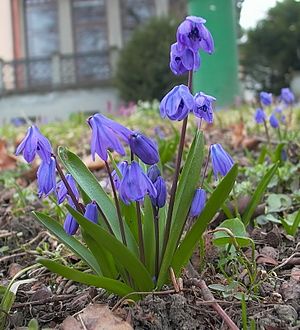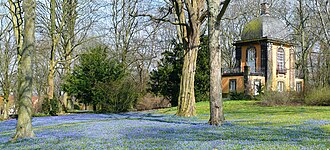Siberian squill
| Siberian squill | ||||||||||||
|---|---|---|---|---|---|---|---|---|---|---|---|---|

Siberian squill ( Scilla siberica ) |
||||||||||||
| Systematics | ||||||||||||
|
||||||||||||
| Scientific name | ||||||||||||
| Scilla siberica | ||||||||||||
| Haw. |

The Siberian squill ( Scilla siberica ), also known as nodding star hyacinth and Siberian star hyacinth , is a species of the squill genus ( Scilla ) belonging to the asparagus family (Asparagaceae).
features
The Siberian squill is similar to the two-leaved squill ( Scilla bifolia ). It has two to four linear foliage leaves on one stem. There are one to three flowers on the 10 to 15 centimeter high stem . Unlike the two-leaved squill, the blue flowers are somewhat bell-shaped and nodding. The seeds of the Siberian squill are also equipped with an elaiosome and can be spread through myrmecochory . It blooms from March to April.
The number of chromosomes is 2n = 12 or 18.
Occurrence
This species of plant comes from the Sarmatian - Pontic region (Turkey, southern Russia, Caucasus, Iran), where it occurs in moist, open forests.
Systematics
One can distinguish four subspecies:
- Scilla siberica subsp. armena (uppercase) Mordak : It occurs from eastern, north-eastern and central Turkey to Transcaucasia and Lebanon.
- Scilla siberica subsp. caucasica (Miscz.) Mordak : It occurs from Transcaucasia to Iraq and Iran.
- Scilla siberica subsp. otschiauriae (Mordak) Mordak : It occurs in the eastern Transcaucasia.
- Scilla siberica subsp. siberica : It occurs from the Crimea to the Caucasus and is a neophyte in many countries in Europe and America.
Culture
In Europe, the Siberian squill is a popular early flowering ornamental plant in gardens and parks. It particularly thrives in shady and partially shaded, fresh locations. Sometimes it grows wild and can then form mass populations. There is a white culture.
literature
- Erich Oberdorfer : Plant-sociological excursion flora , Verlag Eugen Ulmer, Stuttgart, 5th edition, 1983, ISBN 3-8001-3429-2
Individual evidence
- ^ Erich Oberdorfer : Plant-sociological excursion flora for Germany and neighboring areas . With the collaboration of Angelika Schwabe and Theo Müller. 8th, heavily revised and expanded edition. Eugen Ulmer, Stuttgart (Hohenheim) 2001, ISBN 3-8001-3131-5 , pp. 133 .
- ↑ a b c d e Rafaël Govaerts (Ed.): Scilla siberica - data sheet at World Checklist of Selected Plant Families of the Board of Trustees of the Royal Botanic Gardens, Kew. Last accessed on September 13, 2016.
Web links
- Siberian squill. In: FloraWeb.de.
- Siberian squill . In: BiolFlor, the database of biological-ecological characteristics of the flora of Germany.
- Distribution map in the quadrant grid on deutschlandflora.de (Netzwerk Phytodiversität Deutschland eV)
- Scilla siberica Haw. In: Info Flora , the national data and information center for Swiss flora .
- Thomas Meyer: Data sheet with identification key and photos at Flora-de: Flora von Deutschland (old name of the website: Flowers in Swabia )